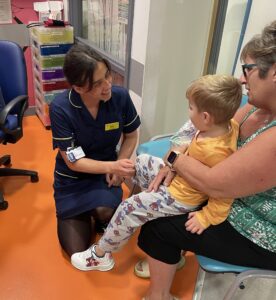13 September 2024

Children’s Nurse Esme Griffiths with a patient undergoing assessment
A new electronic sepsis risk assessment for children being treated in hospital has been launched at the Shrewsbury and Telford Hospital NHS Trust (SaTH).
The launch of the digital sepsis assessment for children and young people follows the successful roll-out of the Paediatric Vitals system in July this year.
Paediatric Vitals replaced the traditional observation paper charts on the children’s unit at the Princess Royal Hospital (PRH) in Telford and in the emergency departments at Royal Shrewsbury Hospital and PRH. The new system means clinicians can instantly access observation charts with real time information from any of the devices within the Trust. This enhances patient safety by giving more accurate and timely monitoring of patients. Stronger monitoring supports early detection and intervention for patients who are at risk of deterioration.
Angela Windsor and Teresa Cole, from the Deteriorating Patient Team, said “The digital sepsis assessment is an incredibly positive step for improving the care of children and young people. The new assessment helps our colleagues with early recognition of sepsis, meaning they can escalate patients that need additional care and provide earlier treatment in response to the condition. Studies show that quicker treatment improves outcomes for sepsis survivors and can reduce long-term effects of post-sepsis syndrome, therefore the early recognition that the digital assessment brings is key”.
The team has worked closely with colleagues across the Trust to design the system to create a safer patient pathway and closer monitoring of children at risk of sepsis.
The latest improvement to the patient pathway for suspected sepsis has been delivered in time to mark World Sepsis Day, which occurs today, Friday 13 September.
Sepsis is a life-threatening reaction to an infection. It happens when your immune system overreacts to an infection and starts to damage your body’s own tissues and organs. It may lead to shock, multi-organ failure, and death – especially if not recognised early and treated promptly.
